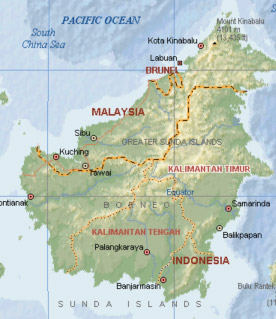The Borneo Orangutan Survival Foundation (BOSF) has successfully released 46 orangutans back into the wild. The orangutans had been rescued from forest fragments and housed for months at the Nyaru Menteng Rescue and Reintroduction Project in Central Kalimantan until suitable — and secure — habitat was located. The release site is a section of rainforest in the upper Barito region of Central Kalimantan, within the Heart of Borneo.
“Here there are several thousand hectares of primary lowland rainforest, in lush green valleys and mountain ridges, divided by large rivers flowing through gorges and over rapids,” noted a statement from BOSF. “The area has plenty of available food for orangutans, as evidenced by ground surveys, yet only supports a small wild orangutan population, probably owing to a combination of historical hunting by indigenous hunter-gatherer tribes (which has now ceased) and the wide rivers and mountain ridges acting as barriers against the species’ dispersal.”
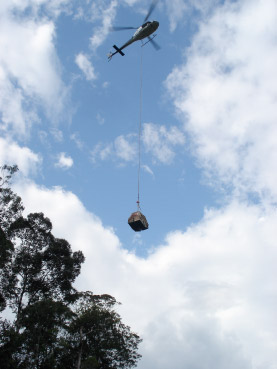 Helicopter carrying an orangutan to a release site. Courtesy of BOSF.
|
Sixty-one orangutans were released in the upper Barito region in 2007 and 2008. In 2009, researchers identified another 20,000 hectares of suitable habitat, which is where the 46 were released over a six day period from August 17th to 22nd.
BOSF reports that fifteen adult males (nine flanged, six unflanged), eleven adult females, seven adolescent males, twelve adolescent females and one female infant (with her mother) were released.
“Those orangutans were then flown to a holding camp near to the release site, ready for their final journey back to the wild. BOS veterinarians were on hand throughout the entire operation to make sure that the apes didn’t suffer too much from the stresses of the journey and were released in a healthy state. Helicopters were used for the final stage of the release. The orangutans were sedated and placed in individual cages, then flown – six or seven to a sling, suspended 100 feet below the helicopter – to the release points, where a team on the ground waited for the helicopter’s arrival and then opened the cages. Six separate release points were chosen, spaced 2 km apart to ensure that the influx of orangutans wouldn’t exceed the forest’s carrying capacity.”
Despite the release, the Nyaru Menteng Center still houses hundreds of orangutans, including many infant orangutans orphaned when their mothers were killed by plantation workers or loggers. About 200 orangutans are ready for immediate reintroduction but BOSF is challenged to find sufficient habitats for additional releases due to large-scale deforestation in Kalimantan, the Indonesian portion of the island of Borneo. Forest loss in Kalimantan is primarily driving by logging, fires, and conversion for oil palm plantations. Habitat destruction has replaced the illegal pet trade as the largest threat to Borneo orangutans, which are listed as endangered by the IUCN. Orangutans in Sumatra are even worse off — they are considered critically endangered with a population now estimated at less than 7,000 individuals.
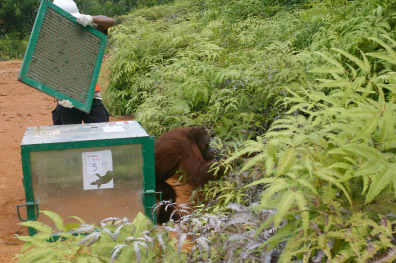 Orangutan at the release site. Courtesy of BOSF. |
The released orangutans will be monitored by BOSF, which has also established ties with local communities to ensure they are aware of the reintroduction project.
BOSF and other groups are hoping that a climate change mitigation mechanism proposed by the U.N. could help fund protection of other suitable forest habitat. REDD, as the scheme is known, would compensate developing countries for reducing emissions from deforestation. Independent of REDD, BOSF and other orangutan conservation groups will still need to continue raising substantial funds to care for the orangutans presently in rehabilitation facilities across Borneo and Sumatra. It can cost more than $2,000 per year to feed and care for an orangutan, which if it is an infant, may be reared for eight to tens years, perhaps longer.
Related
Rehabilitation not enough to solve orangutan crisis in Indonesia
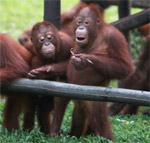
(08/20/2009) A baby orangutan ambles across the grass at the Borneo Orangutan Survival Foundation’s Nyaru Menteng rehabilitation center in Central Kalimantan, in the heart of Indonesian Borneo. The ape pauses, picks up a stick and makes his way over to a plastic log, lined with small holes. Breaking the stick in two, he pokes one end into a hole in an effort to extract honey that has been deposited by a conservation worker. His expression shows the tool’s use has been fruitful. But he is not alone. To his right another orangutan has turned half a coconut shell into a helmet, two others wrestle on the lawn, and another youngster scales a papaya tree. There are dozens of orangutans, all of which are about the same age. Just outside the compound, dozens of younger orangutans are getting climbing lessons from the Borneo Orangutan Survival Foundation (BOS) staff, while still younger orangutans are being fed milk from bottles in a nearby nursery. Still more orangutans—teenagers and adults—can be found on “Orangutan Island” beyond the center’s main grounds. Meanwhile several recently wild orangutans sit in cages. This is a waiting game. BOS hopes to eventually release all of these orangutans back into their natural habitat—the majestic rainforests and swampy peatlands of Central Kalimantan, on the island of Borneo. But for many, this is a fate that may never be realized.
Borneo ablaze: forest fires threaten world’s largest remaining population of orangutans
(08/16/2009) Raging fires have broken out in the peat-swamp forests of Central Kalimantan, Indonesian Borneo, threatening the largest population of orangutans in the world. The fires were started by people but have spread uncontrollably due to the extreme drought that Borneo is currently experiencing as a result of El Niño conditions.
Turning wasteland into rainforest
(07/31/2009) The highly touted reforestation project launched by orangutan conservationist Willie Smits in Indonesian Borneo is detailed in this week’s issue of Science.

(06/04/2009) A new paper by Oscar Venter, a PhD student at the University of Queensland, and colleagues finds that forest conservation via REDD — a proposed mechanism for compensating developing countries for Reducing Emissions from Deforestation and Degradation — could be economically competitive with oil palm production, a dominant driver of deforestation in Indonesia. The study, based on overlaying maps of proposed oil palm development with maps showing carbon-density and wildlife distribution in Kalimantan (Indonesian Borneo), estimates that REDD is financially competitive, and potentially able to fund forest conservation, with oil palm at carbon prices of $10-$33 per ton of carbon dioxide equivalent (tCO2e). In areas with low agricultural suitability and high forest carbon, notably peatlands, Venter and colleagues find that a carbon price of $2 per tCO2e would be sufficient to beat out returns from oil palm.
Orangutan guerrillas fight palm oil in Borneo
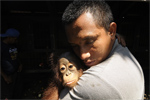
(06/01/2009) Despite worldwide attention and concern, prime orangutan habitat across Sumatra and Borneo continues to be destroyed by loggers and palm oil developers, resulting in the death of up to 3,000 orangutans per year (of a population less than 50,000). Conservation groups like Borneo Orangutan Survival report rescuing record numbers of infant orangutans from oil palm plantations, which are now a far bigger source of orphaned orangutans than the illicit pet trade. The volume of orangutans entering care centers is such that these facilities are running out of room for rescued apes, with translocated individuals sometimes waiting several months until suitable forest is found for reintroduction. Even then they aren’t safe; in recent months loggers have started clearing two important reintroduction sites (forests near Bukit Tigapuluh National Park in Sumatra and Mawas in Central Kalimantan). Meanwhile across half a dozen rehabilitation centers in Malaysia and Indonesia, more than 1,000 baby orangutans—their mothers killed by oil palm plantation workers or in the process of forest clearing—are being trained by humans for hopeful reintroduction into the wild, assuming secure habitat can be found. Dismayed by the rising orangutan toll, a grassroots organization in Central Kalimantan is fighting back. Led by Hardi Baktiantoro, the Center for Orangutan Protection (COP) has mounted a guerrilla-style campaign against companies that are destroying orangutan habitat in Kalimantan, the Indonesian part of Borneo.
